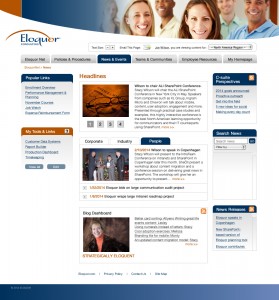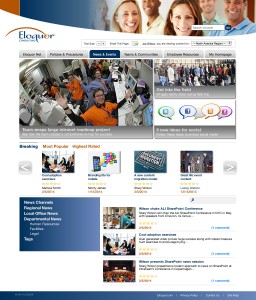When I presented a session at last month’s IntraTeam intranet conference in Copenhagen, I made one big assumption:
organizational news is not just the domain of the corporate communicator
I’ve believed this for a long time. What I didn’t account for is how many communication teams are still stuck in the 1990s believing that news only comes from a command and control process through corporate communication. As a result, I was surprised by some of the questions I received during and after the session. Questions such as:
- “How do social channels fit into a consolidated view of news?”
- “What about news items from other departments?”
- “Why don’t you just show the activity feed and let them use that?”
Let me say it loud and clear:
any news hub on your intranet or digital workplace must integrate both channels controlled by corporate communication and those that are not
Newer technologies (those of you unafraid of “social” can read this as “social technologies”) give us unprecedented ability to extend publishing permissions to many internal experts. Good workflow and optional moderation gives us a comfortable level of control. The SharePoint-based news tool ElevatePoint News does this very effectively.
But, not every channel presented in a centralized news hub (a concept I addressed in my earlier post about news) need be controlled or moderated. Some should be open to the ebb and flow of our still evolving digital conversation. Witness this example visual which is patterned after approaches various clients have taken (we just cannot show their version):

A sample news hub rendered from a client example that integrates a limited amount of social content. Click to enlarge.
In this example, there is a collection of recent blog posts. You wouldn’t have to call them “blogs” if the organization weren’t ready for that. Call it “Team News.” Presumably these could be authored by anyone in the organization. The tab labeled “Corporate” – how our client referred to information about the company – could incorporate news from any author, not just those in corporate communication.
Open up publishing to the many
Push the concepts of integration and open communication channels another step further and you get this:
This combines the need for control in some channels with the opportunity to display free-wheeling social content. Pull in content from any team, any location, any channel. Use tagging, usage and rating to crowdsource. Permission a big group to contribute, or leave the door entirely open. This answers the question about news from other teams, who may want to publish their own content. There’s no reason to restrict their publishing rights. And, while our research shows a majority of users prefer to go to one central place to find news, that doesn’t preclude you from duplicating a widget on that department’s site to display their narrow filter of news.
At the same time, this approach offers employees better search and discovery than the activity feed, which I’ll address next.
About the activity feed
The activity feed was designed to enable me, an individual user, to view a stream of content  I choose to see. Authors who interest me scroll by in the feed in real time. Sure, I could go painstakingly through it to catch up with where I last was, but if I follow a lot of people, I’m not likely to do this. Add in corporate content, and my feed may get unwieldy. Thus the advent of tools like TweetDeck to help us organize all that important information into categories. First, consider these important characteristics of the activity feed:
- It’s transient, fleeting and not searchable
- It offers little control over presentation or prioritization
- Individual user feeds depend upon users following/liking a page, site or document; a behavior the vast majority of users still won’t exhibit
Here are my suggestions for incorporating activity feeds:
- Never rely exclusively on an activity feed to delivery important content to employees, particularly shift workers
- Consider putting a generic activity feed of all new posts (controlled and not controlled) on the home page to attract eyeballs; don’t put this on your news hub
- Be cautious about forcing corporate news into individual user activity feeds; less is more, so limit the content to really important material
It’s about balance
In the end, it comes down to delivering content employees require to make good decisions during their day-to-day work. Talk to employees, observe usage patterns, listen to your digital workplace. Great content no longer resides in just one department. Open the doors to more authors and experts, provide the right guardrails, integrate the right tools and then step back and watch. Good internal online news is partly about redefining what news is.


Recent Comments